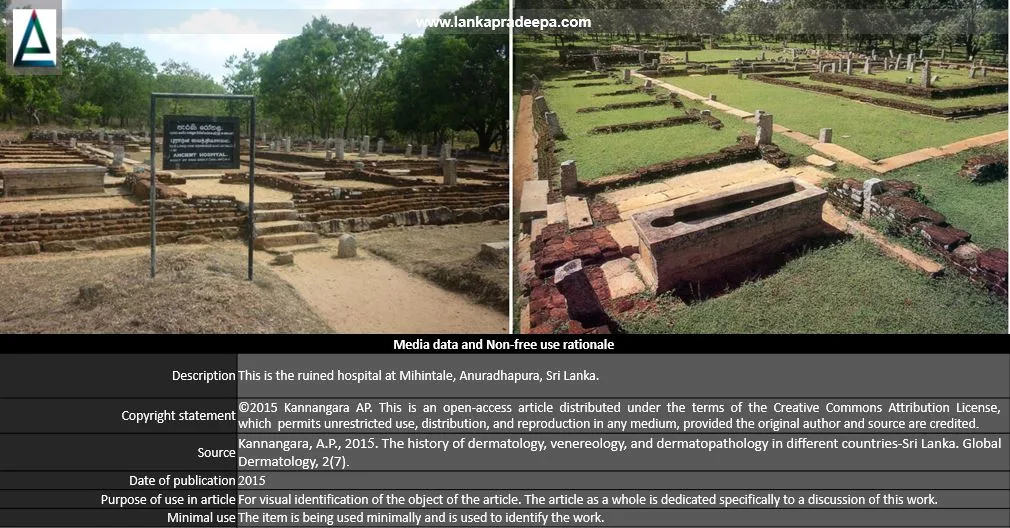
|
Mihintale Ancient Hospital Complex |
The ruins of an Ancient Hospital Complex (Sinhala: මිහින්තලේ පුරාණ රෝහල) are found on the Mihintale Monastery premises in Anuradhapura District, Sri Lanka. These ruins are considered the oldest archaeological evidence available for a hospital in Sri Lanka or perhaps in the world (Mueller-Dietz, 1996).
History
It has been identified that this is the hospital mentioned in Mahavamsa that was built by King Sena II (853-887 A.D.) on the premises of Segiriya [(present Mihintale) Gamage & Thilakarathna, 2018; Jayasuriya, 2016; Nicholas, 1963]. An inscribed rectangular stone pillar of King Udaya II (887-898 A.D.) discovered at this site in 1952 mentions certain immunities granted by the king in respect of the land on which the Mihintale hospital (Segiriya ved-hala) had been located (Gamage & Thilakarathna, 2018; Ranawella, 2001). Another inscription of King Kassapa IV (909-914 A.D.) that was discovered at this site also enabled scholars to identify this ruined building complex as a hospital (Ranawella, 2001).
Excavations
Archaeological Commissioner H.C.P. Bell excavated this site and described his findings in 1910 (Mueller-Dietz, 1996). Commissioner Senarath Paranavitana resumed the archaeological research of the site in 1947 (Mueller-Dietz, 1996). It was further excavated and conserved by the Department of Archaeology in 1954 (Jayasuriya, 2016).
Excavations carried out at this site have unearthed some surgical instruments, various ceramic vessels, and two blue glass flasks from Persia (Jayasuriya, 2016; Mueller-Dietz, 1996; Wikramagamage, 2004). Of them, the surgical instruments have shown their tendency towards a high stand technology and similarity with some surgical instruments of modern-day western medical science. The flasks from Persia show evidence of the cultural and trade connections between middle-east countries and Sri Lanka in ancient times (Gamage & Thilakarathna, 2018). Some of these artefacts are presently on the display in Anuradhapura Archaeological Museum and in Colombo National Museum.
The Hospital Building
The ruined building is 118.6 m in length and 97.6 m in width and mainly consists of two sections; the outer and the inner court (Gamage & Thilakarathna, 2018; Mueller-Dietz, 1996; Wikramagamage, 2004). The main entrance faces the south and there are two more entrances in the east and north directions. The inner court is surrounded by a corridor leading to 27 residential rooms for patients (Gamage & Thilakarathna, 2018). All these rooms face the central courtyard and in the middle of which are the ruins of a brick-built shrine room (Gamage & Thilakarathna, 2018; Prematilleke, 1996).
The southern side of the building is the outer court. It consists of four rooms; a hot water and steam bathroom, a clinic (consulting room), a room of medicine stores and a room for grinding medicine (Gamage & Thilakarathna, 2018).
The Medicinal Trough (Beheth Oruwa)
A stone medicinal trough similar to a sarcophagus is found in the northeast corner of the inner court section. Hewn from a monolith, it has an external length of 2.16 m, a width of 0.76 m and a height of 0.59 m (Mueller-Dietz, 1996). It has been used for treating patients by immersing in medicinal oil.

Related Posts
Read Also
References
Books, Journal Articles
1) Gamage, U. and Thilakarathna, N.T.S., 2018. Hospital Complexes in Ancient Sri Lanka: An Observational Study of Mihinthale Hospital Complex. International Journal of Liberal Arts and Social Science, 6(1), pp.35-44.
2) Jayasuriya, E., 2016. A guide to the Cultural Triangle of Sri Lanka. Central Cultural Fund. ISBN: 978-955-613-312-7. pp.60-61.
3) Mueller-Dietz, H.E., 1996. Stone sarcophagi and ancient hospitals in Sri Lanka. Medizinhistorisches Journal, (H. 1/2), pp.49-65.
4) Nicholas, C. W., 1963. Historical topography of ancient and medieval Ceylon. Journal of the Ceylon Branch of the Royal Asiatic Society, New Series (Vol VI). Special Number: Colombo. Royal Asiatic Society (Ceylon Branch). p.164.
5) Prematilleke, L., 1996. Ancient monastic Hospital System in Sri Lanka. Ancient trades and cultural contacts in Southeast Asia, Bangkok, The
Office of the National Culture Commission, pp.115-126.
6) Ranawella, S., 2001. Inscription of Ceylon. Volume V, Part I. Department of Archaeology. ISBN: 955-9159-21-6. pp.102-103.
7) Wikramagamage, C., 2004. Heritage of Rajarata: Major natural, cultural, and historic sites. Colombo. Central Bank of Sri Lanka. p.173.


